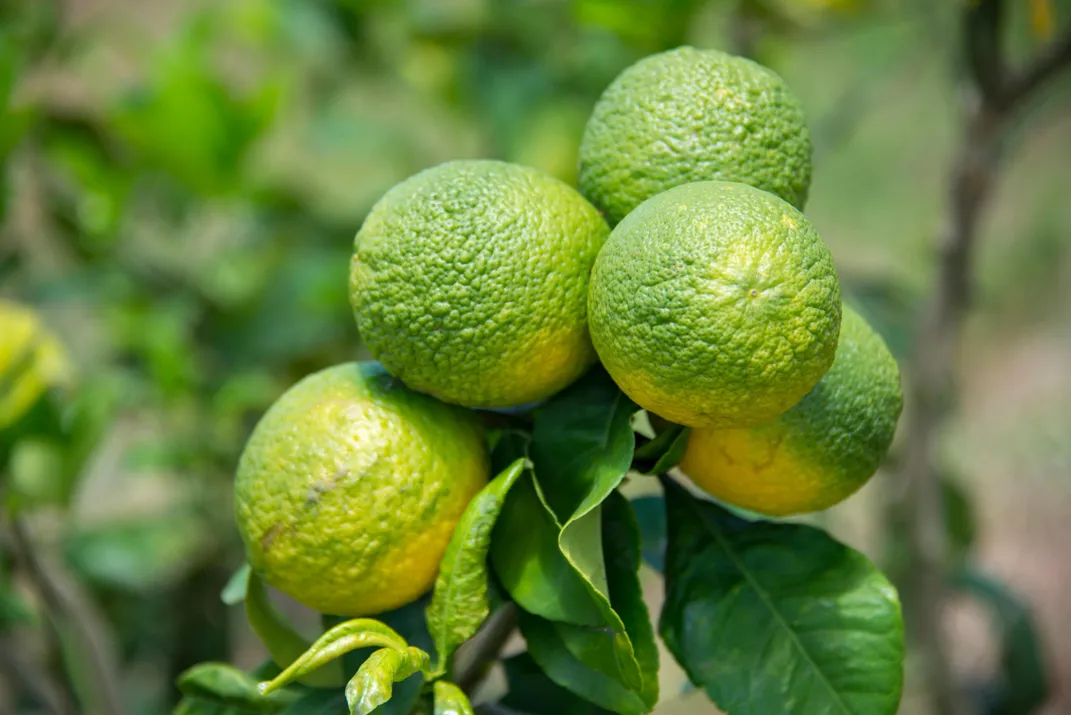How the Australian Finger Lime Could Save American Citrus
Scientists found the gene that makes finger limes impervious to a disease turning oranges green and bitter
/https://tf-cmsv2-smithsonianmag-media.s3.amazonaws.com/filer/06/75/06754269-f3c1-4101-b462-75da518dba8d/fdm0kj.jpg)
Citrus greening, also called huanglongbing or HLB, has upended the citrus-growing industry in Florida and put other American citrus producers, like those in California, on high alert. Now, 15 years after the disease first appeared in the United States, researchers at the University of California, Riverside have found a substance that might stop it.
Researchers’ best lead came from finger limes, an unusual citrus fruit that grows in Australia’s rainforests. The pickle-shaped fruits are full of caviar-like beads of juice, and the limes are immune to citrus greening. After finding the gene that grants the limes their immunity, the researchers used it to create the natural HLB-fighting protein. In controlled settings, spraying young trees with the protein killed the disease, Jeanette Marantos reports for the Los Angeles Times.
"When I heard that there are some wild citrus close relatives that show tolerance or partial resistance, then I (felt) like there must be some genes responsible for it,” she tells Greg Allen at NPR.
UC Riverside geneticist Hailing Jin began studying finger limes’ DNA ten years ago, and it took five years to find the genetic culprit for resistance to citrus greening. Since then, they have been testing its effect on trees in the lab and controlled greenhouses.
The disease is caused by bacteria carried by an invasive insect called the Asian citrus psyllid. It causes the fruit to turn bitter and green, and kills the tree if left unchecked for too long, per the Los Angeles Times. In Florida, citrus greening caused a severe drop in orange production, from about 300 million boxes produced in 2000 to only about 70 million boxes last year, according to NPR.

Hot zones of citrus greening infections have popped up in Texas’ commercial orange groves and California’s residential areas, so California’s groves have taken aggressive steps to remove infected trees nearby and spray pesticides to kill the citrus psyllid. But the pesticides, like pyrethroid and neonicotinoid, are toxic to bees.
The finger limes’ protein is safer and more resilient than other chemicals made to fight the bacteria directly. The finger lime protein remains effective at 130 degrees Fahrenheit, and it’s easy to manufacture and safe for humans, Jin tells the Los Angeles Times. When the researchers treated infected trees with the protein, their new growth was HLB-free. And when sprayed on young trees, the solution protects them from future infections, according to a statement.
Speaking to John Cox at the Record, the president of California Citrus Mutual called the discovery a potential breakthrough. But while the protein is exciting, he says, “a lot of things work in the lab and don't work out in the field. You never know what's going to work until it actually does."
UC Riverside has partnered with the biotechnology company Invaio Sciences to market and produce the antibiotic, but first the researchers need to conduct more tests and obtain government approval.
“We were supposed to start the field trials as soon as the pandemic goes away,” Jin tells the Los Angeles Times, “but now, with positive [coronavirus] cases surging in Florida, we don’t see how the state will be reopened anytime soon. So we have to wait.”
It may be years until the protein is commercially available to protect citrus plants, so the researchers recommend continuing to remove HLB-infected trees and protecting groves against future outbreaks. One infected tree could lead to outbreaks miles away because of how far the psyllid flies.
But if the product comes to fruition, it would help a lot of farmers.
"It appears to be something that can really help us turn the corner," Matt Fisher, a fourth-generation farmer in California’s Central Valley, tells the Record. "This HLB is, other than water [shortages], our single-greatest threat in this business."